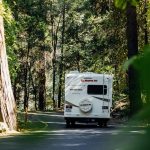Male Vandergrift
RV Life: Managing Laundry on the Road
RV Life: Managing Laundry on the Road
Embarking on an RV adventure is an exhilarating experience that offers unparalleled freedom. However, with this freedom comes the challenge of managing everyday tasks like laundry. If you’re wondering how to keep your clothes fresh and clean while living the RV life, you’re in the right place! Let’s dive into some practical tips and tricks for managing laundry on the road. 🧺
Table of Contents
1. Embracing Laundromats
2. Portable Laundry Solutions
3. Tips for Efficient Laundry Days
4. Conclusion
5. FAQs
Embracing Laundromats 🏢
Laundromats are a staple for many RV travelers. They are convenient and often located near popular RV parks or campsites. Here’s how to make the most of your laundromat visits:
Plan Ahead: Before setting out to a new location, research nearby laundromats. Apps like Yelp or Google Maps can help you find places with good reviews.
Be Prepared: Keep a stash of quarters and laundry detergent handy. Some laundromats offer card payments, but it’s always good to have cash as a backup.
Time It Right: Visit during off-peak hours to avoid crowds. Early mornings or late evenings are often quieter, allowing you to get in and out quickly.
Portable Laundry Solutions 🚐
If laundromats aren’t your style, consider investing in portable laundry solutions. Here are some options that fit perfectly into RV living:
Manual Washers: Hand-cranked or pedal-powered washers are compact and efficient. They require minimal water and work well for small loads.
Portable Washing Machines: These are electric-powered and can handle slightly larger loads. They’re perfect for longer trips where laundromats may not be available.
Clotheslines and Drying Racks: Fresh air drying can be refreshing and energy-efficient. Invest in a retractable clothesline or a collapsible drying rack to save space in your RV.
Tips for Efficient Laundry Days 🧺
When laundry day rolls around, a little organization goes a long way. Here are some tips to streamline the process:
Sort As You Go: Use separate bags or bins for whites, colors, and delicates. This saves time when you’re ready to wash.
Consolidate Loads: Wait until you have full loads to conserve water and energy. This is especially important if you’re using portable machines.
Use Multi-purpose Detergents: Opt for detergents that work well in both hot and cold water to accommodate different washing conditions.
Conclusion
Managing laundry on the road doesn’t have to be a daunting task. With a bit of planning and the right equipment, you can keep your clothes clean and fresh, leaving more time to enjoy your adventures. Whether you choose laundromats or portable solutions, the key is to find what works best for your lifestyle. Happy travels! 🌍
FAQs
Q: How often should I do laundry while living in an RV?
A: It depends on your wardrobe size and personal preference, but typically once a week is sufficient for most travelers.
Q: Can I use regular laundry detergent in portable washing machines?
A: Yes, but it’s best to use a low-suds detergent to prevent overflows and ensure efficient cleaning.
Q: Are there eco-friendly laundry options for RVers?
A: Absolutely! Consider biodegradable detergents and solar-powered dryers for a greener approach to laundry on the road.
How to Make Your RV Energy Efficient
How to Make Your RV Energy Efficient 🚐💡
Exploring the open road in your RV is one of life’s great pleasures. But, while you’re out there soaking in the sights, it’s also important to consider your energy consumption. Making your RV energy efficient not only helps the environment but can also save you money in the long run. In this guide, we’ll explore practical, straightforward ways to optimize your RV’s energy use.
Table of Contents
1. Understanding Energy Needs
2. Upgrade to LED Lighting
3. Solar Panels: Power from the Sun 🌞
4. Insulation: Keep the Temperature Just Right 🌡️
5. Energy-Efficient Appliances
6. Mindful Water Usage 🚿
7. Conclusion
8. FAQs
Understanding Energy Needs
Before diving into upgrades, it’s crucial to understand your RV’s energy needs. Each RV is unique, and knowing how much power you use on average helps in making informed decisions. Consider your lifestyle—do you prefer boondocking off-grid or staying at campgrounds with hookups? This will guide your energy efficiency strategy.
Upgrade to LED Lighting 💡
If you haven’t already switched to LED lights, now’s the time. LED lights use significantly less energy than traditional incandescent bulbs and have a much longer lifespan. They’re a simple upgrade that can make a noticeable difference in your RV’s energy consumption.
Solar Panels: Power from the Sun 🌞
Solar panels are a fantastic investment for RV owners. They provide a renewable energy source that can keep your batteries charged without relying on a generator or shore power. Look for portable solar panel kits for easy setup and use. Remember, the initial cost may be high, but the long-term savings and independence are worth it.
Insulation: Keep the Temperature Just Right 🌡️
Good insulation helps maintain a comfortable temperature inside your RV, reducing the need for heating and cooling. Consider adding window coverings, thermal curtains, or reflective insulation materials. It’s a cozy way to enhance energy efficiency and comfort.
Energy-Efficient Appliances
Modern appliances are designed to be more energy-efficient than their older counterparts. If your RV is equipped with older appliances, consider upgrading to newer models. Look for ENERGY STAR-rated appliances, which use less power and water.
Mindful Water Usage 🚿
Water usage is closely tied to energy consumption, especially if your RV uses an electric water heater. Try installing low-flow showerheads and faucets to conserve water. Additionally, be mindful of your water heating habits to save energy.
Conclusion
Making your RV energy efficient is a rewarding endeavor. Not only do you lower your environmental footprint, but you also enjoy longer stretches off-grid with the money saved on energy costs. By understanding your energy needs and implementing these tips, you can enjoy a more sustainable and enjoyable RV lifestyle.
FAQs
Q: How much can I save by switching to LED lighting in my RV?
A: Switching to LED lighting can reduce your lighting energy consumption by up to 75%, leading to significant savings over time.
Q: Are solar panels effective for all RV types?
A: Yes, solar panels can be adapted to most RVs. The key is to assess your energy needs and choose a solar setup that fits your consumption and space.
Q: What’s the average cost of installing solar panels on an RV?
A: The cost can vary widely, but a basic setup might start around $500 and increase based on the size and number of panels.
Q: How often should I upgrade my RV appliances for energy efficiency?
A: It’s a good idea to review your appliances every 5-10 years or as new, more efficient technologies become available.
Q: Can I insulate my RV myself?
A: Yes, many insulation projects can be done as DIY tasks. Just ensure you follow safety guidelines and use suitable materials.
By implementing these energy-efficient strategies, you’re not only enhancing your RV experience but also contributing to a more sustainable future. Happy travels! 🌍
Top Tips for RVing in Canada
Top Tips for RVing in Canada: Your Ultimate Guide to an Unforgettable Adventure 🇨🇦
Dreaming of the open road, majestic landscapes, and cozy nights under the stars? RVing in Canada offers all this and more. Whether you’re a seasoned road warrior or a newbie, this guide is packed with essential tips to make your Canadian RV adventure truly epic!
Table of Contents
1. Planning Your Route
2. Essential Gear to Pack
3. Campground Dos and Don’ts
4. Safety Tips for RVing
5. Conclusion
6. FAQs
Planning Your Route 🗺️
Canada’s vastness means endless possibilities for RV routes. Start by considering what you want to see. Are you drawn to the rugged beauty of the Rockies, or do the coastal vistas of the Maritimes call your name? Tools like Google Maps and RV-specific apps can help plot a course that aligns with your interests.
Pro Tip: Always check the weather conditions and road closures, especially if you’re traveling in early spring or late fall. The Canadian climate can be unpredictable!
Essential Gear to Pack 🎒
Traveling in an RV doesn’t mean leaving comfort behind. Here’s a quick checklist of must-have items:
– Warm clothing and waterproof gear (Canadian weather is full of surprises!)
– A reliable GPS and physical maps (technology isn’t foolproof)
– Cooking essentials and non-perishable food
– First-aid kit and personal medications
– Portable charger and extra batteries
Campground Dos and Don’ts 🏕️
Respecting campground rules ensures a pleasant experience for everyone:
Do: Arrive early to secure a good spot and follow quiet hours. Greet your neighbors and make new friends!
Don’t: Leave campfires unattended or litter. Always leave your site cleaner than you found it.
Safety Tips for RVing 🚐
Your safety is paramount when RVing. Here are some key pointers:
– Regularly check tire pressure and fluid levels.
– Keep an eye on fuel levels, especially in remote areas where gas stations are scarce.
– Know the dimensions of your RV, particularly the height, to avoid unexpected collisions with low bridges.
– Store emergency contact information and familiarize yourself with local wildlife protocols.
Conclusion
Embarking on an RV journey through Canada is an adventure like no other. With these tips in hand, you’re set for a safe, enjoyable, and unforgettable experience. Remember, the journey is just as important as the destination. Happy RVing! 🌟
FAQs
Q: What is the best time of year to RV in Canada?
A: The summer months (June to August) are ideal for RVing in Canada due to the mild weather and open campgrounds.
Q: Are there any RV rental options in Canada?
A: Yes, there are several RV rental companies across Canada. It’s advisable to book in advance, especially during peak season.
Q: Can I park my RV anywhere overnight?
A: While Canada offers many overnight parking options, it’s important to respect local laws and only park in designated areas or campgrounds.
Q: How do I handle waste disposal while RVing?
A: Most campgrounds have waste disposal stations. Always follow environmental guidelines to ensure proper disposal.
Q: Do I need a special license to drive an RV in Canada?
A: For most RVs, a standard driver’s license is sufficient. However, for larger motorhomes, you may need a special endorsement. Check with local authorities for specifics.
How to Boost Your RV’s WiFi Signal
How to Boost Your RV’s WiFi Signal 🚐📶
Traveling in an RV offers the freedom to explore the world at your own pace, but staying connected can be a challenge. With spotty WiFi signals in remote areas, keeping up with emails, streaming your favorite shows, or even working on the road can become frustrating. Fear not! This guide will provide you with effective strategies to boost your RV’s WiFi signal, ensuring you’re always connected wherever your wheels take you.
Table of Contents
1. Understanding Your RV’s WiFi Needs
2. Invest in a WiFi Booster 📡
3. Use a Cellular Hotspot 📱
4. Optimize Your RV’s Interior for Better Signal
5. Explore Antennas and Extenders
6. Conclusion
7. FAQs
Understanding Your RV’s WiFi Needs
Before jumping into solutions, it’s crucial to understand your specific WiFi needs. Are you a digital nomad who needs a reliable connection for work? Or is your priority streaming movies and surfing the web? Understanding your usage will guide your decisions when selecting the right equipment.
Invest in a WiFi Booster 📡
One of the most effective ways to enhance your WiFi signal is by investing in a WiFi booster. These devices amplify existing signals, making them stronger and more reliable. Consider models like the WeBoost or Alfa WiFi Camp Pro, which are designed specifically for RVs. They can significantly improve connectivity, especially in areas with weak signals.
Use a Cellular Hotspot 📱
A cellular hotspot can be a game-changer for staying connected on the road. These devices use cellular data to create a WiFi network in your RV, allowing multiple devices to connect. Look for plans with generous data allowances and good coverage in the areas you plan to visit. Carriers like Verizon and AT&T offer robust options that can keep you connected even in remote locations.
Optimize Your RV’s Interior for Better Signal
Believe it or not, the layout of your RV can affect your WiFi signal. Large metal objects, appliances, and even the RV’s structure can obstruct signals. Try rearranging your RV to minimize these obstacles. Place your devices near windows or in areas with fewer barriers to improve connectivity.
Explore Antennas and Extenders
If you’re still struggling with WiFi, consider adding antennas or extenders to your setup. An external RV antenna can capture distant signals more effectively, while a WiFi extender can amplify these signals inside your RV. Together, they can work wonders in boosting your connectivity.
Conclusion
Boosting your RV’s WiFi signal doesn’t have to be a daunting task. By understanding your needs, investing in the right equipment, and optimizing your RV’s setup, you can enjoy a strong and reliable internet connection wherever your adventures take you. Happy travels and happy browsing! 🌍✨
FAQs
Q: Can I use a regular home WiFi booster in my RV?
A: While you might be tempted to use a home WiFi booster, RV-specific boosters are designed to handle the unique challenges of mobile connectivity and are usually a better choice.
Q: How do I choose the best cellular plan for my RV travels?
A: Look for plans with nationwide coverage and generous data allowances. It’s also wise to check reviews or forums for feedback from other RV travelers about their experiences with specific carriers.
Q: Are there any free tools to check my WiFi signal strength?
A: Yes! Apps like WiFi Analyzer (for Android) and Network Analyzer (for iOS) can help you understand your current signal strength and identify potential areas for improvement.
Q: Can poor weather affect my RV’s WiFi signal?
A: Yes, heavy rain or storms can interfere with WiFi signals, reducing their strength. Investing in high-quality equipment can help mitigate these effects.
RV Life: How to Meet Other RVers
RV Life: How to Meet Other RVers
Embarking on the open road in your RV is an exhilarating adventure. 🌟 The freedom to explore new places and the comfort of having your home on wheels is unmatched. But let’s face it, sometimes it can get a bit lonely out there. Meeting fellow RVers can enhance your travels, offering companionship, tips, and a sense of community. In this post, we’ll explore how you can connect with other RV enthusiasts along your journey.
Table of Contents
1. Join RV Communities Online
2. Attend RV Rallies and Meetups
3. Explore Campgrounds and RV Parks
4. Participate in Social Media Groups
5. Be Friendly and Approachable
6. Conclusion
7. FAQs
Join RV Communities Online
The digital world is an excellent starting point for connecting with like-minded individuals. Websites and forums such as iRV2 and RVillage are bustling with RV enthusiasts eager to share experiences, advice, and even organize meetups. By joining these communities, you can start conversations, ask questions, and even plan to meet up with others who are on a similar route.
Attend RV Rallies and Meetups
Nothing brings RV enthusiasts together like a good rally or meetup. 🚐 These events are designed specifically for RVers and typically include fun activities, educational seminars, and plenty of socializing opportunities. Check out events like the Escapees RV Club Escapade or FMCA events. They’re packed with people who share your lifestyle and interests.
Explore Campgrounds and RV Parks
Campgrounds and RV parks are natural gathering spots for RVers. When you pull in, take a walk around and say hello to your neighbors. Many parks host communal events like potlucks or game nights, perfect for making new friends. Don’t forget to check out bulletin boards for any upcoming local events or gatherings.
Participate in Social Media Groups
Facebook, Instagram, and other social media platforms are buzzing with RV groups. 📱 Whether you’re looking for travel inspiration, maintenance tips, or just a chat, these groups can be a valuable resource. Engaging with posts, sharing your own stories, and even arranging meetups through these platforms can expand your RV network significantly.
Be Friendly and Approachable
Sometimes, the simplest way to meet new people is to be open and approachable. A smile and a wave can go a long way in starting a conversation. Offer help if you see someone struggling with their setup or ask for help with a problem of your own. Genuine interactions often lead to lasting friendships. 😊
Conclusion
Meeting other RVers is not only about enriching your travel experience but also about building a community on the road. Whether you’re parked at a scenic campground or attending a bustling RV rally, opportunities to connect abound. So, open up, reach out, and enjoy the camaraderie that RV life has to offer.
FAQs
Q: How do I find RV rallies happening in my area?
A: Check online forums, RV club websites, and social media groups. Many events are announced through these channels, often with detailed schedules and sign-up information.
Q: Are there any apps that can help me connect with other RVers?
A: Yes, apps like RVillage and Meetup can help you find and coordinate with other RVers who are nearby or traveling along the same routes.
Q: What should I bring to a meetup or rally?
A: Bring your enthusiasm, a friendly attitude, and any items needed for specific activities, like a dish to share at a potluck or materials for a workshop.
Q: How do I stay safe when meeting new people on the road?
A: Always meet in public, well-lit places, and let someone know your plans. Trust your instincts and don’t hesitate to remove yourself from uncomfortable situations.
How to Choose the Perfect RV Mattress
How to Choose the Perfect RV Mattress 🛌
Are you gearing up for your next big road trip and dreaming of restful nights under the stars? Choosing the perfect RV mattress can make all the difference between a blissful adventure and a bumpy ride. Let’s dive into how you can find the best fit for your RV and ensure sweet dreams on the road! 🌙
Table of Contents
1. Understanding Your Space
2. Types of RV Mattresses
3. Comfort and Support
4. Materials Matter
5. Budget Considerations
6. Conclusion
7. FAQs
Understanding Your Space 🚐
Before you embark on the journey to find your dream mattress, the first step is understanding the exact dimensions of your RV’s sleeping area. RV spaces can be quite unique, and knowing your space will save you the hassle of returning an ill-fitting mattress. Measure carefully and keep those numbers handy!
Types of RV Mattresses 🔍
RV mattresses come in a variety of types, each offering different benefits:
Memory Foam
Memory foam mattresses are popular for their ability to contour to your body, providing excellent support and comfort. If you’re looking to feel like you’re sleeping on a cloud, this might be your pick!
Innerspring
Classic and reliable, innerspring mattresses offer a familiar bounce and generally have a longer lifespan. They are often more breathable than foam, which can be a perk during warmer nights.
Latex
Latex mattresses are known for being eco-friendly and durable. They provide a great balance of comfort and support, and are naturally resistant to dust mites and mold, making them a healthy choice for many.
Comfort and Support 💤
Your RV adventures should be filled with excitement and not backaches! Look for a mattress that provides the right level of support for your body. Consider factors like firmness, your sleeping position, and personal comfort preferences. A mattress that’s too firm or too soft can lead to uncomfortable nights.
Materials Matter 🧐
When selecting an RV mattress, materials can significantly impact your comfort and health. Opt for breathable, hypoallergenic materials if you have allergies. Also, consider temperature regulation features if you travel through varying climates.
Budget Considerations 💰
While it’s tempting to splurge on the most luxurious option, it’s essential to find a balance between comfort and cost. Set a budget that works for you, keeping in mind that a high-quality mattress is an investment in your well-being and happiness.
Conclusion 🌟
Choosing the perfect RV mattress might seem daunting, but with the right information, it can be a fun journey. By considering space, type, comfort, materials, and budget, you’ll be well on your way to finding the ideal mattress for your home on wheels. Here’s to restful nights and adventurous days! 🚐💤
FAQs
What size mattress fits in an RV?
RV mattresses come in various sizes, like RV Queen, RV King, and even custom sizes. Measure your space carefully to ensure the perfect fit.
Can I use a regular mattress in my RV?
While you can use a regular mattress, RV mattresses are specifically designed to fit the unique dimensions and needs of an RV space. Consider the weight and size before opting for a standard home mattress.
How long do RV mattresses last?
The lifespan of an RV mattress can vary, but generally, they last between 5 to 8 years, depending on usage and quality.
How can I make my RV mattress more comfortable?
Adding a mattress topper or pad can enhance comfort and provide additional support without the need for a new mattress.
Happy travels and sweet dreams! 🛌✨
The Best RV Covers for Winter Storage
The Best RV Covers for Winter Storage: Keep Your RV Safe and Sound! ❄️
As the leaves begin to fall and the temperatures drop, it’s time to start thinking about winter storage for your beloved RV. Protecting your RV during the harsh winter months is crucial to ensuring its longevity and performance. But with so many options out there, how do you choose the best RV cover for winter storage? Fear not, RV enthusiasts! We’ve got you covered (pun intended). This guide will walk you through everything you need to know to make an informed decision.
Table of Contents
1. Why Covering Your RV for Winter Matters
2. Key Features to Look for in an RV Cover
3. Top Choices for RV Covers This Winter
4. How to Choose the Right RV Cover for Your Needs
5. FAQs: Your RV Cover Questions Answered
Why Covering Your RV for Winter Matters 🌨️
Your RV is a significant investment, and just like any other asset, it needs protection from the elements. Winter can be particularly harsh, with snow, ice, and freezing temperatures that can wreak havoc on your RV’s exterior and interior. Here are a few reasons why covering your RV during winter is essential:
1. Prevents Moisture Damage: A quality RV cover will keep moisture out, preventing mold, mildew, and rust from forming.
2. Shields from UV Rays: Even in winter, the sun’s UV rays can fade your RV’s paint and weaken its roof.
3. Protects Against Snow and Ice: A durable cover will prevent snow and ice buildup, which can weigh down and damage your RV.
Key Features to Look for in an RV Cover 🔍
When shopping for an RV cover, consider the following features to ensure you get the best protection possible:
1. Material: Look for covers made from heavy-duty, waterproof, and breathable materials like polypropylene or polyester.
2. Fit: Choose a cover that fits snugly over your RV, with adjustable straps and buckles to keep it secure.
3. Ventilation: Opt for a cover with built-in vents to allow moisture to escape and reduce wind stress.
4. Accessibility: Some covers come with zippered panels for easy access to your RV’s doors and compartments.
Top Choices for RV Covers This Winter 🏆
Based on our research and customer reviews, here are some of the best RV covers for winter storage:
1. ADCO Designer Series: Known for its excellent fit and durability, this cover features triple-layer SFS AquaShed top panel for maximum moisture protection.
2. Classic Accessories OverDrive: With its PermaPRO fabric, this cover offers great breathability and weather resistance.
3. Camco UltraGuard: Made from heavy-duty polypropylene fabric, it provides superior protection against snow and UV damage.
How to Choose the Right RV Cover for Your Needs 🤔
Not sure which cover to pick? Consider these tips to make the best choice:
1. Measure Your RV: Always measure your RV’s length, width, and height to ensure a proper fit.
2. Consider Your Climate: If you live in an area with heavy snowfall, opt for a cover specifically designed for winter conditions.
3. Budget: While quality covers can be pricey, they are a worthwhile investment to protect your RV.
FAQs: Your RV Cover Questions Answered ❓
Q1: Can I use a tarp instead of an RV cover?
A1: While tarps are inexpensive, they lack breathability and can trap moisture, leading to mold and mildew. A dedicated RV cover is a better choice.
Q2: How often should I check on my RV during winter?
A2: It’s a good idea to inspect your RV every few weeks to ensure the cover is secure and there’s no damage from snow or ice.
Q3: Do RV covers come with warranties?
A3: Yes, many high-quality RV covers come with warranties. Always check the warranty terms before purchasing.
We hope this guide helps you find the perfect RV cover to keep your home-on-wheels safe and sound this winter. Happy RVing! 🚐✨
RV Life: Managing Finances on the Road
RV Life: Managing Finances on the Road 🚐💸
Welcome to the world of RV living! Whether you’re a seasoned traveler or new to this adventurous lifestyle, managing finances while exploring the open road is crucial. In this blog post, we’ll dive into practical tips and tricks to help you budget like a pro, without compromising on the joys of RV life. Let’s hit the road to financial freedom! 🌟
Table of Contents
- Create a Realistic Budget
- Track Your Expenses
- Save on Fuel
- Find Affordable Campsites
- Earn on the Road
- Conclusion
- FAQs
Create a Realistic Budget 📝
Before you set off on your journey, it’s important to establish a realistic budget. Consider your monthly income and expenses. Factor in costs like RV maintenance, insurance, food, entertainment, and emergency savings. A well-planned budget helps avoid surprises and keeps your finances in check.
Track Your Expenses 📊
Tracking expenses is key to staying within your budget. Use apps like Mint or YNAB (You Need A Budget) to monitor your spending. Keeping tabs on expenses helps identify areas where you can cut back, and ensures you’re not overspending.
Save on Fuel ⛽
Fuel is one of the biggest expenses in RV living. To save, plan your routes efficiently and avoid unnecessary detours. Use apps like GasBuddy to find the cheapest gas stations. Regular maintenance of your RV also improves fuel efficiency.
Find Affordable Campsites 🏕️
Campsite fees can quickly add up. Consider staying at free or low-cost sites like national forests or Bureau of Land Management (BLM) lands. Memberships with clubs like Good Sam or Passport America offer discounts at various campgrounds.
Earn on the Road 💼
If you’re looking to supplement your income while traveling, there are several ways to earn on the road. Consider remote work, freelancing, or seasonal jobs. Platforms like Upwork and Fiverr offer opportunities to work from anywhere.
Conclusion 🎉
Managing finances on the road doesn’t have to be daunting. By planning wisely, tracking your expenses, and finding creative ways to save and earn, you can enjoy the freedom and adventure of RV life without financial stress. Remember, it’s all about balance and enjoying the journey! 🚐✨
FAQs 🤔
Q1: How do I handle unexpected expenses on the road?
A: It’s wise to have an emergency fund specifically for such situations. Always set aside a portion of your budget for unexpected repairs or medical emergencies.
Q2: Are there any tax benefits to living in an RV?
A: Yes, if your RV is considered your primary residence, you may qualify for certain tax deductions. It’s best to consult with a tax professional to understand your specific situation.
Q3: How can I reduce food costs while traveling?
A: Cooking meals in your RV saves money compared to dining out. Stock up on groceries when you find good deals and plan meals ahead to minimize waste.
Q4: What are some tips for making the most out of my RV budget?
A: Always shop around for the best prices, be it for fuel, campsites, or groceries. Taking advantage of loyalty programs and discounts can also stretch your budget further.
Q5: Can I finance my RV purchase?
A: Yes, many lenders offer RV loans. It’s important to shop around for the best interest rates and terms before committing to a loan.
We hope these tips help you manage your finances effectively while enjoying the RV lifestyle. Safe travels and happy budgeting! 🌍✨
How to Find and Book the Best RV Campsites
How to Find and Book the Best RV Campsites 🚐
Embarking on an RV adventure promises freedom, exploration, and a connection with nature that few other experiences can match. However, the key to a successful RV trip often lies in choosing the right campsite. Whether you’re a seasoned road warrior or a newbie to the RV lifestyle, this guide will help you discover and book the best RV campsites for your journey.
Table of Contents
1. Understanding Your Needs
2. Researching RV Campsites
3. Tips for Booking the Best Spots
4. Making the Most of Your Stay
5. Conclusion
6. FAQs
Understanding Your Needs 🌟
Before you set out to find the perfect campsite, it’s essential to understand your specific requirements. Are you looking for a tranquil escape in the wilderness, or do you prefer a site with all the amenities of home?
Consider factors like:
– Location: Proximity to attractions, hiking trails, or fishing spots.
– Amenities: Hookups for water, electricity, and sewer, Wi-Fi, bathhouses, and laundry facilities.
– Size: Ensure the site can accommodate the size of your RV.
– Budget: Campsite fees can vary widely; decide on a budget that works for you.
Researching RV Campsites 🔍
Once you have a clear idea of what you need, it’s time to dive into research. Here’s how to get started:
– Online Directories: Websites like Campendium, RV Park Reviews, and Good Sam provide comprehensive listings with user reviews.
– Community Recommendations: Engage with RV communities on social media platforms or forums. Fellow travelers can offer invaluable insights and hidden gems.
– Apps: Use apps like AllStays or RV Parks & Campgrounds to find campsites on the go.
Tips for Booking the Best Spots 📅
Once you’ve narrowed down your options, it’s time to book. Here are some tips to secure the best sites:
– Book Early: Popular campsites can fill up quickly, especially during peak seasons. Booking in advance increases your chances of getting a prime spot.
– Check Cancellation Policies: Make sure you’re aware of cancellation fees or policies should your plans change.
– Call the Campsite: A quick call can confirm the availability of specific amenities and provide the latest information.
Making the Most of Your Stay ⛺
After booking, it’s all about enhancing your camping experience:
– Arrive Early: This gives you time to set up and explore the area.
– Respect the Rules: Follow campsite guidelines to ensure a pleasant stay for everyone.
– Explore Local Attractions: Make the most of your location by visiting nearby attractions or trying local cuisine.
Conclusion 🎉
Finding and booking the best RV campsites can seem daunting, but with a bit of planning and research, it can be a rewarding part of your adventure. Remember, the journey is just as important as the destination. So pack your bags, hit the road, and enjoy the freedom of the open road!
FAQs 🤔
Q: What should I consider when choosing an RV campsite?
A: Consider location, amenities, size, and budget to find a site that best fits your needs.
Q: How far in advance should I book an RV campsite?
A: For popular sites, it’s best to book several months in advance, especially during peak travel seasons.
Q: Are there apps to help find RV campsites?
A: Yes, apps like AllStays and RV Parks & Campgrounds are excellent tools for finding and booking campsites.
Q: Can I cancel my campsite reservation?
A: Most campsites allow cancellations, but be sure to check their specific policy regarding fees and deadlines.
Happy camping and safe travels! 🚐🌲
Best Books and Movies for RV Road Trips
Best Books and Movies for RV Road Trips 🚐
Embarking on an RV road trip is an exciting adventure, filled with the promise of new experiences and the freedom of the open road. But even the most thrilling journeys can use a bit of entertainment to pass the time. Whether you’re parked under the stars or cruising down the highway, having the right books and movies on hand can enhance your road trip experience. In this post, we’ll explore some of the best books and movies to accompany you on your journey. Let’s dive in!
Table of Contents
1. Books for Thoughtful Wanderers 📚
2. Movies for Every Mood 🎬
3. Audiobooks for a Captivating Drive 🎧
4. Conclusion: Packing Entertainment with Purpose 🎒
5. FAQs 🔍
Books for Thoughtful Wanderers 📚
Books are the perfect companion for those quiet moments in the RV or by the campfire. Here are some must-reads that align with the spirit of the road:
“On the Road” by Jack Kerouac
Considered the quintessential American road trip novel, “On the Road” captures the essence of adventure and exploration. It’s a great read to inspire your journey and ignite a sense of wanderlust.
“Wild” by Cheryl Strayed
This memoir recounts one woman’s solo hike along the Pacific Crest Trail. It’s a powerful story of self-discovery and resilience, perfect for those moments when you seek inspiration and reflection.
“Travels with Charley: In Search of America” by John Steinbeck
Join Steinbeck and his poodle, Charley, as they traverse the United States. This book offers a charming perspective on the American landscape and the people who inhabit it.
Movies for Every Mood 🎬
Movies are a great way to unwind after a day of exploration. Here are some films that will resonate with the road-tripping spirit:
“The Motorcycle Diaries”
This film chronicles the early travels of Che Guevara across South America. It’s a visually stunning exploration of the continent and a poignant look at personal transformation.
“Little Miss Sunshine”
A hilarious and heartwarming tale of a family road trip in a VW bus. It showcases the ups and downs of family travel, and it’s sure to bring laughter and joy to your journey.
“Into the Wild”
Based on a true story, this film follows a young man’s quest for meaning in the Alaskan wilderness. It’s a powerful reminder of the beauty and danger of the natural world.
Audiobooks for a Captivating Drive 🎧
If you prefer to keep your eyes on the road, audiobooks are a fantastic way to enjoy a story. Here are a few recommendations:
“The Alchemist” by Paulo Coelho
This philosophical tale of a shepherd’s journey to find his personal legend is both entertaining and thought-provoking, making it perfect for long drives.
“Born a Crime” by Trevor Noah
Noah’s memoir about growing up in apartheid South Africa is both hilarious and moving. His narration adds an extra layer of authenticity and humor.
“Harry Potter Series” by J.K. Rowling
Jim Dale’s narration of the Harry Potter series is a magical experience in itself. Perfect for families or anyone looking to escape into a world of fantasy.
Conclusion: Packing Entertainment with Purpose 🎒
As you prepare for your RV road trip, consider packing a mix of books, movies, and audiobooks to keep everyone entertained. Whether you’re seeking inspiration, laughter, or a gripping story, these recommendations are sure to enhance your travel experience. Remember, the journey is just as important as the destination, so enjoy every moment!
FAQs 🔍
What are some good books for a short road trip?
For shorter trips, consider novellas or short story collections like “The Ocean at the End of the Lane” by Neil Gaiman or “Interpreter of Maladies” by Jhumpa Lahiri.
Are there any family-friendly movies suitable for RV trips?
Absolutely! Movies like “Finding Nemo,” “The Incredibles,” and “Moana” are perfect for the whole family to enjoy.
Can you recommend an audiobook for a long drive?
“The Goldfinch” by Donna Tartt is a lengthy, immersive audiobook that is perfect for long drives, offering a deep dive into a captivating story.
Happy travels, and may your road trip be filled with unforgettable stories and adventures! 🚐✨









